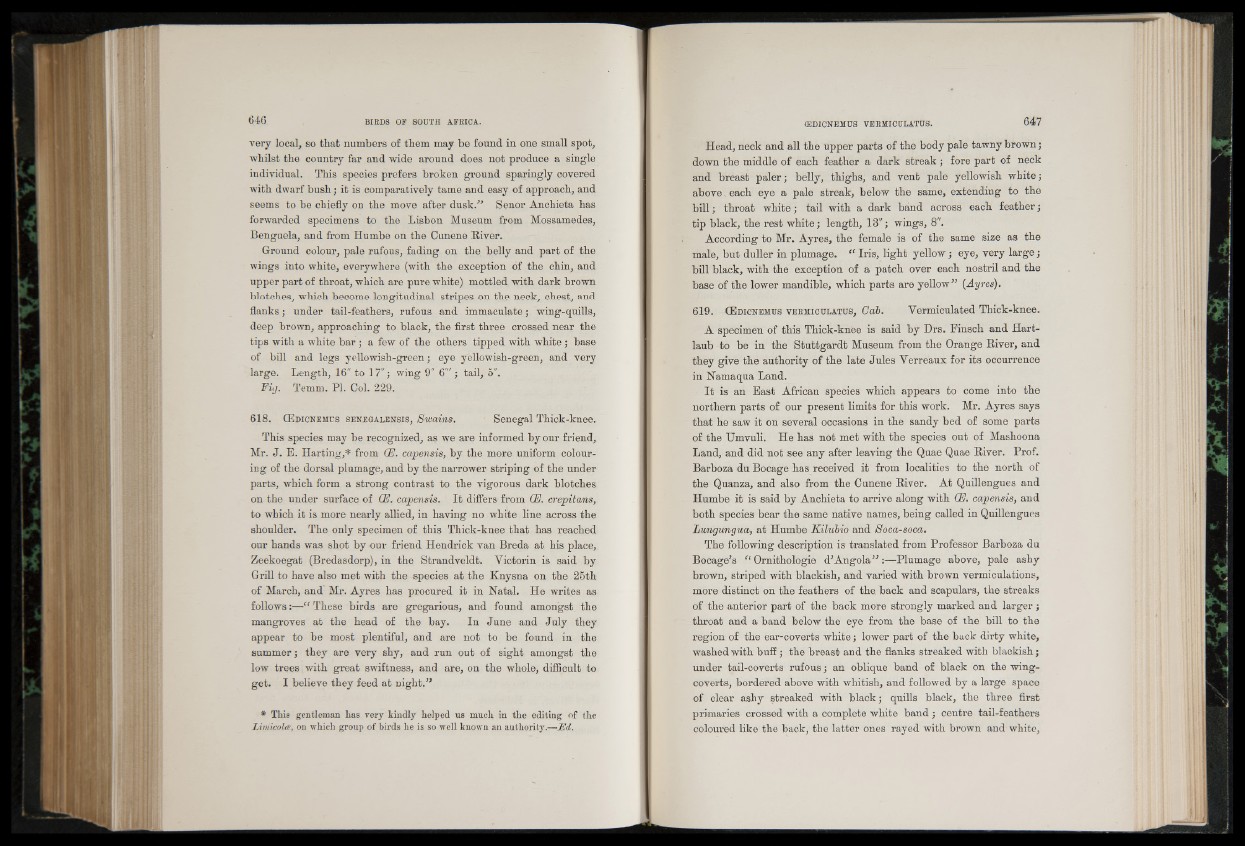
very local, so that numbers of them may be found in one small spot,
whilst the country far and wide around does not produce a single
individual. This species prefers broken ground sparingly covered
with dwarf bush; it is comparatively tame and easy of approach, and
seems to be chiefly on the move after dusk/'’ Senor Anchieta has
forwarded specimens to the Lisbon Museum from Mossamedes,
Benguela, and from Humbe on the Cunene River.
Ground colour, pale rufous, fading on the belly and part of the
wings into white, everywhere (with the exception of the chin, and
upper part of throat, which are pure white) mottled with dark brown
blotches, which become longitudinal stripes on the neck, chest, and
flanks; under tail-feathers, rufous and immaculate; wing-quills,
deep brown, approaching to black, the first three crossed near the
tips with a white bar ; a few of the others tipped with white ; base
of bill and legs y ellowish-green; eye yellowish-green, and very
large. Length, 16" to 17"; wing 9" 6"'; tail, 5".
Fig. Temm. PI. Col. 229.
618. ( E d i c n e m u s s e n e g a l e n s i s , Swains. Senegal Thick-knee.
This species may be recognized, as we are informed by our friend,
Mr. J. E. Harting,* from CE. capensis, by the more uniform colouring
of the dorsal plumage, and by the narrower striping of the under
parts, which form a strong contrast to the vigorous dark blotches
on the under surface of CE. capensis. It differs from (E. crepitans,
to which it is more nearly allied, in having no white line across the
shoulder. The only specimen of this Thick-knee that has reached
our hands was shot by our friend Hendrick van Breda at his place,
Zeekoegat (Bredasdorp), in the Strandveldt. Victorin is said by
Grill to have also met with the species at the Knysna on the 25th
of March, and Mr. Ayres has procured it in Natal. He writes as
follows:—“ These birds are gregarious, and found amongst the
mangroves at the head of the bay. In June and July they
appear to be most plentiful, and are not to be found in the
summer; they are very shy, and run out of sight amongst the
low trees with great swiftness, and are, on the whole, difficult to
get. I believe they feed at night.”
* This gentleman has very kindly helped us much in the editing of the
Limicolce, on which group of birds he is so well known an authority.—Ed.
Head, neck and all the upper parts of the body pale tawny brown;
down the middle of each feather a dark streak; fore part of neck
and breast paler; belly, thighs, and vent pale yellowish white;
above, each eye a pale streak, below the same, extending to the
bill; throat white; tail with a dark band across each feather;
tip black, the rest white; length, 13"; wings, 8".
According to Mr. Ayres, the female is of the same size as the
male, but duller in plumage. “ Iris, light yellow; eye, very large;
bill black, with the exception of a patch over each nostril and the
base of the lower mandible, which parts are yellow” (Ayres).
619. ( E d i c n e m u s v e e m i c u l a t u s , Gab. Yermiculated Thick-knee.
A specimen of this Thick-knbe is said by Drs. Pinsch and Hart-
laub to be in the Stuttgardt Museum from the Orange River, and
they give the authority of the late Jules Verreaux for its occurrence
in Namaqua Land.
I t is an East African species which appears to come into the
northern parts of our present limits for this work. Mr. Ayres says
that he saw it on several occasions in the sandy bed of some parts
of the Umvuli. He has not met with the species out of Mashoona
Land, and did not see any after leaving the Quae Quae River. Prof.
Barboza du Bocage has received it from localities to the north of
the Quanza, and also from the Cunene River. At Quillengues and
Humbe it is said by Anchieta to arrive along with CE. capensis, and
both species bear the same native names, being called in Quillengues
Lungungua, at Humbe Kilubio and Soca-soca.
The following description is translated from Professor Barboza du
Bocage’s “ Ornithologie d’Angola” :—Plumage above, pale ashy
brown, striped with blackish, and varied with brown vermiculations,
more distinct on the feathers of the. back and scapulars, the streaks
of the anterior part of the back more strongly marked and larger;
throat and a band below the eye from the base of the bill to the
region of the ear-coverts white; lower part of the back dirty white,
washed with buff; the breast and the flanks streaked with blackish;
under tail-coverts rufous; an oblique band of black on the wing-
coverts, bordered above with whitish, and followed by a large space
of clear ashy streaked with black; quills black, the three first
primaries crossed with a complete white band; centre tail-feathers
coloured like the back, the latter ones rayed with brown and white,